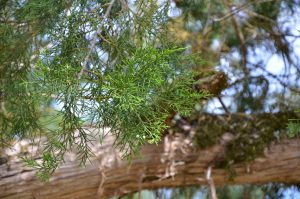
By Les Harrison
Wakulla County Extension Director
Being repulsive is not normally an enviable quality. All it guarantees is rejection, rebuff and isolation from any and all who would wander into close proximity.
History and Hollywood are replete with stories of the unlucky who, despite many other fine qualities, were repugnant to the population at large. Included in this list were monsters, nonconformists and miscreants who possessed at least one vile or hideous trait which was generally perceived as insurmountable.
Wakulla County has its own candidate for repellent champion, for at least some of the native inhabitants. The native Southern Red Cedar and its lumber are high on the list with some local insect residents as a reason to stay away.
The Southern Red Cedar is a common and rarely noticed juniper, at least by the area’s human residents. It grows wild in forested areas and is occasionally used as a landscape specimen or windbreak.
There are other cedars and members of the juniper family which have been transplanted into the area, including the closely related Eastern Red Cedar. All have been used as landscape enhancements.
For the area’s moth population, the presence of cedar is a story with an unhappy ending. Southern Red Cedar lumber or shavings is the only natural, native reason to find other lodgings, but many of the non-native junipers also produce the compound cedrol which wards off insects.
The annals of history do not identify the person who first realized cedar wood is bad news for moths. No doubt it was someone who had a wool sweater and was weary of local moths’ preference for this textile.
The discovery proved popular and created a niche furniture industry. Cedar chest, cedar lined closets and bags of cedar shavings all were used to eliminate moth damage and add the sweet scent to the woolens.
Wool was an important addition to any cool season wardrobe because it is the only natural textile which can get wet and keep the wearer warm at the same time. Unfortunately, cedar could not withstand the rigors of sea travel and saltwater.
In the days before synthetic moth repellants, sea chests were made from camphor wood. This native of southeast Asia did withstand exposure to seawater and repel moths, but with a very distinct and strong odor.
Another insect pest which is susceptible to cedar is the carpet beetle. Like moths, they have a distinct preference for wool products, but will consume a number of other animal derived items used in upholstery, clothing or floor coverings.
The newly hatched larvae will die upon exposure to cedar, but mature insects are only repelled. Additionally, the cedar must be fresh to work effectively.
The development of synthetic repellants and textiles in the 20th century dramatically lessened the demand for cedar as a timber product.
Still they have an important function in Wakulla County’s environment. The native Hairstreak butterflies are dependent on southern red cedar as a food source.
Birds and a variety of wildlife species utilize the cedar berries as a seasonal food source. Even the occasional ornamental pest, bagworms, will shelter in and dine on southern red cedar foliage.
Being repellant must be a matter of perspective.
To learn more about Southern Red Cedar and its uses in Wakulla County, visit the UF/IFAS Wakulla County website at https://blogs.ifas.ufl.edu/wakullaco or call 850-926-3931.
 0
0
